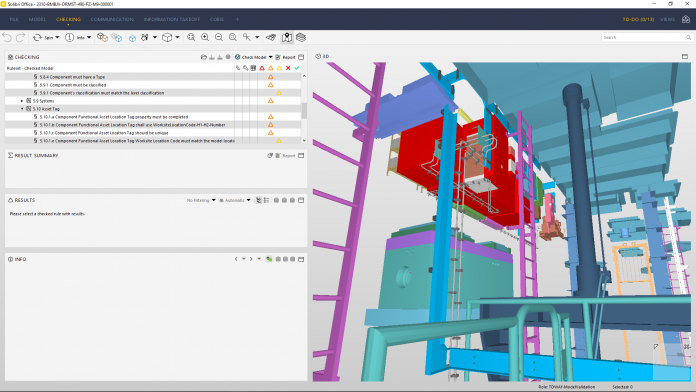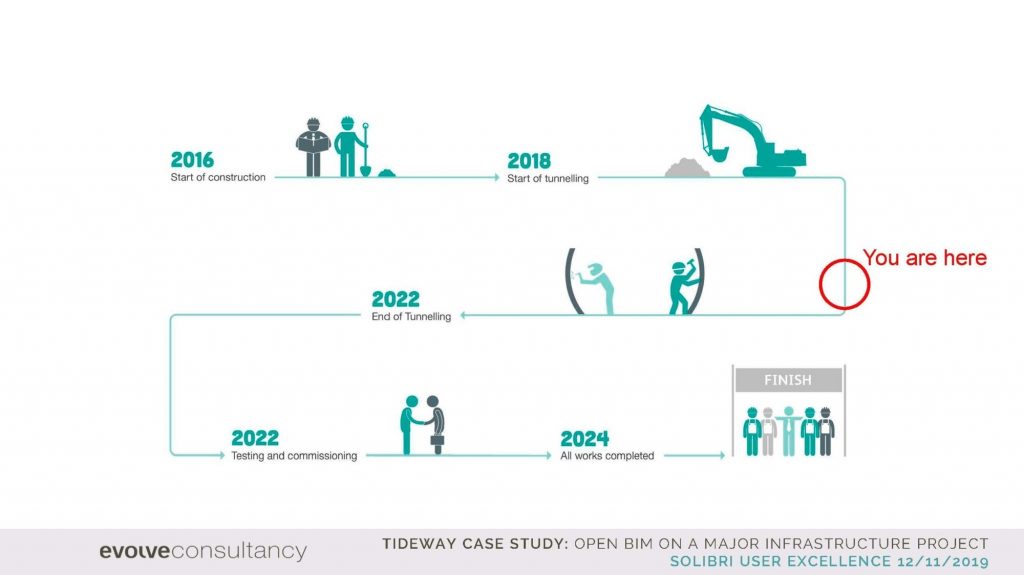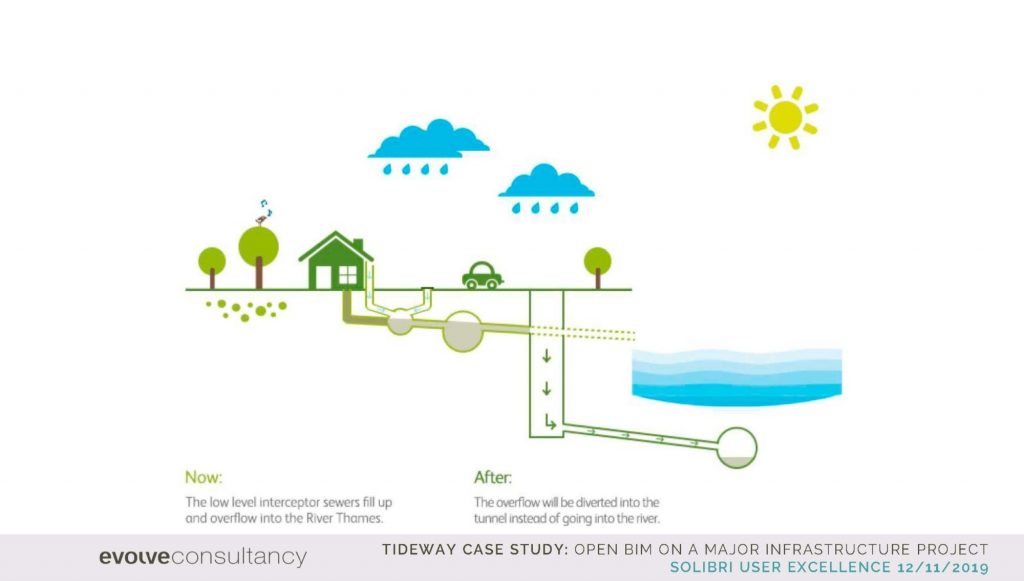Solibri and Evolve Consultancy collaborate on the Thames Tideway Tunnel project to adapt an Open BIM approach to support a flexible information flow
The Thames Tideway Tunnel project is a significant undertaking that will tackle the problem of sewage overflows and expand the capacity of the London sewage network to meet European environmental standards. Evolve Consultancy works as a technology and information advisor on the project, and for them, Solibri has had a key role in assuring the quality of the project’s model data and the Open BIM strategy.
Underneath London lies a sewerage network, a system designed in the Victorian Era. Even though the sewer structure is still in good condition, despite its age, it has a shortcoming – it can’t handle today’s population. Due to the increase of people, it spills millions of tonnes of sewage into the tidal section of the Thames every year, polluting the river.
The Thames Tideway Tunnel project was established to solve the pollution problem. Preparatory work on the project began in 2015 and is due to be completed in 2024, consisting the design and construction of a large tunnel below the river. In practice, this means 24 construction sites handled by three Main Works Contractors, all of which are JVs.
Solibri and Evolve Consultancy collaborate on major infrastructure project
Tideway is the company delivering the Thames Tideway Tunnel. Evolve Consultancy is a BIM and design technology consultancy. They were brought in to help advise on the scope of technology and how it can make all the disparate parts of the project work together.
Nigel Davies, the founding director of Evolve Consultancy, said: “We’ve been working on the project for about six years now. We have been involved in the specification of the information requirements, and the process we’re now going through is looking at the information we’re going to receive from the Main Works Contractors, and how to validate and check that it is what it is intended to be. It’s a significant undertaking!”
Solibri, Evolve Consultancy and Tideway were awarded BIM Project of the Year in November 2019 at “The Hammers” Construction Computing Awards. The award is in recognition of the successful implementation of IFC on a major infrastructure project.
Open BIM approach to support open and flexible information flow
From the start, Tideway had decided on an Open BIM strategy. No matter what the information delivered in the project is going to be used for at the end; the key thing is that it’s as open and as flexible as possible. Another decision made from the start was not to dictate certain types of software.
Davies commented: “We specified the open BIM approach because we wanted to let the delivery teams pick and use the best software for what they need it to be. What we have done instead is to look at the process of validating information when it comes in from a number of different sources. As we don’t know what software are going to be used, we have specified a complete series of open standards.
“We are aiming at consistent delivery through the open BIM solutions. The information can be delivered in their native file formats, in IFC and COBie, or even 3D PDFs for those people who don’t have that level of technology to review the data.
“Solibri has been one of the fundamentals that we’ve built on right at the start of the Tideway project.”
He added: “If we went back to the old CAD days, then no matter what people were using, we would have looked at DWG as the format for interchange of information. But we have moved beyond that now. What we’ve really tried to do is to avoid proprietary solutions. Being, for one, the length of the project – five years ago, we wouldn’t be crystal ball gazing to see what’s available in the future, what people would we be using, so we tried to minimize that down to a lowest common denominator, and that happens to be what we’re now terming in the industry: Open BIM.
“How the information has got to us isn’t so important – what is important is specifying the structure and the consistency of that data, and in this project, it is through the open BIM solutions. IFC is the key carrier for that information, not just in terms of format, but in terms of the structure of the data. With that, we can look at the asset information requirements at far later down the line, and we can always map things from a consistent delivery that we’re receiving to a consistent output that the end-user, Thames Water, will require.”
Checking the model information quality
Davies said: “We started using Solibri a number of years ago for validating models. We had been advised to take a look at it and when we started using it, it was one of those lightbulb moments of: ‘why haven’t we been using this before? This is exactly what we need!’ Now it is invaluable to all the projects that we work with.
“Solibri has been one of the fundamentals that we’ve built on right at the start of the Tideway project. As we decided to go down the IFC route, we needed something that can handle the data and validate what we receive. There’s an awful lot of data on the project – there will be literally thousands of models issued, all containing data that we need to validate.”
He added: “Part of the process of defining these standards has been the validation we require from the Main Works Contractors as they issue the information. We have come up with about two hundred separate checks on every piece of information that comes in. Without automation that would be a very manual process taking ten times longer than the project has still got left to run.
“So, for us, Solibri is the key: We’re bringing models in, running through the validation process to make sure we’ve got all the information we need and that it is used correctly. Without Solibri, I’d be here 24 hours a day for the next ten years trying to check anything. So, it’s been invaluable to us.
“Without a doubt, if you can logically put down the questions you’re asking, Solibri will be able to deliver it for you.”
Evolve Consultancy is encouraging a collaborative feedback loop with the Main Works Contractors. They have worked together in a series of workshops to look at the IFC data together, checking the information and demonstrating how the quality is improved.
“We’re not there to validate the data and point fingers, we’re there to validate and identify where, if the information was to be delivered to the client, it wouldn’t be accepted – and more importantly, how to actually address that and make sure the information is acceptable when it comes in.
“Without looking at this quality improvement, we’d be faced with the typical, traditional way of pointing the blame finger and trying to work out who did what wrong. But now we are focusing on making sure everyone does the right thing instead,” said Davies.
Nigel Davies recommends Solibri to anyone who has anything to do with information exchange on a project.
“Anybody who needs to understand the value contained within a model, Solibri is invaluable for them. It can look at the geometry, it can look at the basic things like clash detection, but to be honest, so can other things. But I think the benefit to Solibri is when you take the information model and you look at it as a whole; not just graphically, but also in terms of the information that’s contained within that.
“How do you extract value from that model? If you’re looking and answering that question, in any respect to do with any part of design or construction delivery, Solibri is something you should be looking at. Without a doubt, if you can logically put down the questions you’re asking, Solibri will be able to deliver it for you.”



















